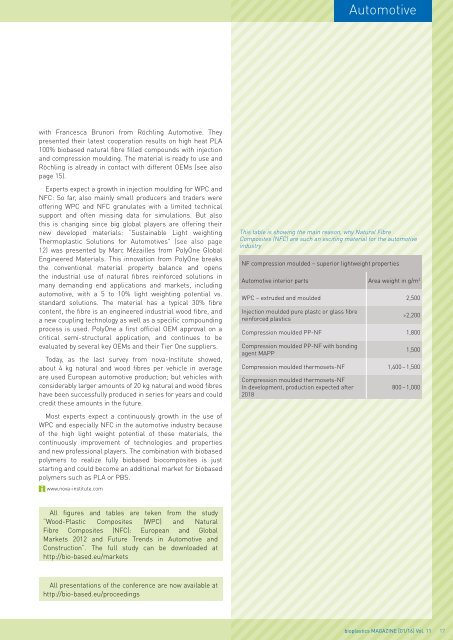Issue 01/2016
Automotive Foam Basics: Public Procurement
Automotive
Foam
Basics: Public Procurement
You also want an ePaper? Increase the reach of your titles
YUMPU automatically turns print PDFs into web optimized ePapers that Google loves.
Automotive<br />
with Francesca Brunori from Röchling Automotive. They<br />
presented their latest cooperation results on high heat PLA<br />
100% biobased natural fibre filled compounds with injection<br />
and compression moulding. The material is ready to use and<br />
Röchling is already in contact with different OEMs (see also<br />
page 15).<br />
Experts expect a growth in injection moulding for WPC and<br />
NFC: So far, also mainly small producers and traders were<br />
offering WPC and NFC granulates with a limited technical<br />
support and often missing data for simulations. But also<br />
this is changing since big global players are offering their<br />
new developed materials: “Sustainable Light weighting<br />
Thermoplastic Solutions for Automotives” (see also page<br />
12) was presented by Marc Mézailles from PolyOne Global<br />
Engineered Materials. This innovation from PolyOne breaks<br />
the conventional material property balance and opens<br />
the industrial use of natural fibres reinforced solutions in<br />
many demanding end applications and markets, including<br />
automotive, with a 5 to 10% light weighting potential vs.<br />
standard solutions. The material has a typical 30% fibre<br />
content, the fibre is an engineered industrial wood fibre, and<br />
a new coupling technology as well as a specific compounding<br />
process is used. PolyOne a first official OEM approval on a<br />
critical semi-structural application, and continues to be<br />
evaluated by several key OEMs and their Tier One suppliers.<br />
Today, as the last survey from nova-Institute showed,<br />
about 4 kg natural and wood fibres per vehicle in average<br />
are used European automotive production; but vehicles with<br />
considerably larger amounts of 20 kg natural and wood fibres<br />
have been successfully produced in series for years and could<br />
credit these amounts in the future.<br />
Most experts expect a continuously growth in the use of<br />
WPC and especially NFC in the automotive industry because<br />
of the high light weight potential of these materials, the<br />
continuously improvement of technologies and properties<br />
and new professional players. The combination with biobased<br />
polymers to realize fully biobased biocomposites is just<br />
starting and could become an additional market for biobased<br />
polymers such as PLA or PBS.<br />
www.nova-institute.com<br />
This table is showing the main reason, why Natural Fibre<br />
Composites (NFC) are such an exciting material for the automotive<br />
industry<br />
NF compression moulded – superior lightweight properties<br />
Automotive interior parts Area weight in g/m 2<br />
WPC – extruded and moulded 2,500<br />
Injection moulded pure plastc or glass fibre<br />
reinforced plastics<br />
>2,200<br />
Compression moulded PP-NF 1,800<br />
Compression moulded PP-NF with bonding<br />
agent MAPP<br />
1,500<br />
Compression moulded thermosets-NF 1,400 – 1,500<br />
Compression moulded thermosets-NF<br />
In development, production expected after<br />
2<strong>01</strong>8<br />
800 – 1,000<br />
All figures and tables are teken from the study<br />
“Wood-Plastic Composites (WPC) and Natural<br />
Fibre Composites (NFC): European and Global<br />
Markets 2<strong>01</strong>2 and Future Trends in Automotive and<br />
Construction“. The full study can be downloaded at<br />
http://bio-based.eu/markets<br />
All presentations of the conference are now available at<br />
http://bio-based.eu/proceedings<br />
bioplastics MAGAZINE [<strong>01</strong>/16] Vol. 11 17


















